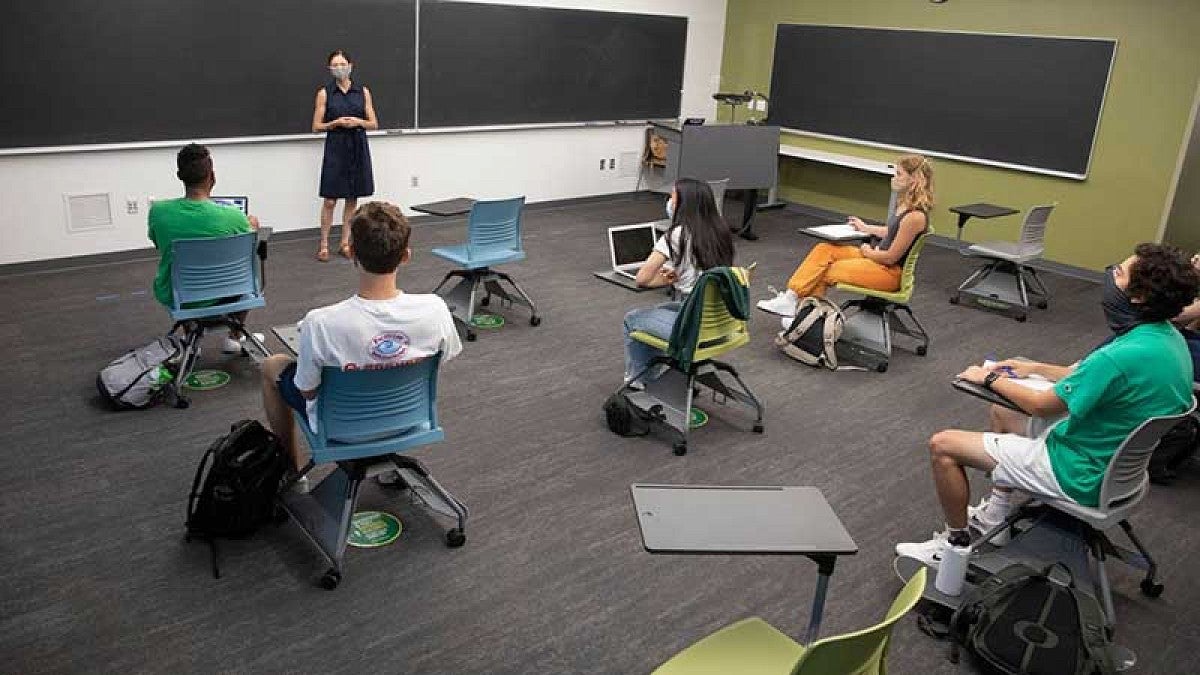More than 20 UO faculty members are participating in a fall 2020 pilot of the HyFlex teaching method, a method that combines face-to-face learning with simultaneously streamed remote instruction.
The Office of the Provost launched the pilot at the start of fall term in partnership with Information Services.
With the administrative decision to continue with a mostly remote, online and hybrid instruction format during winter term, HyFlex will continue to give faculty members the option to return to the classroom while still supporting students who are learning while away from campus.
HyFlex classrooms use technology — including microphones, instructor and document cameras, and touchpads — to capture real-time instruction. Instructors also can request a Zoom assistant to help with technical needs and ensure remote students are able to engage with the material.
“We are lucky to have such an engaged cohort of committed faculty members who are helping us identify how to successfully implement the HyFlex experience for instruction,” said Janet Woodruff-Borden, executive vice provost for academic affairs. “This mixed-delivery mode provides flexibility for students to participate in person or remotely, but creating this instructional approach so that all students are engaged brings a new set of challenges to teaching. Our cohort faculty are sharing their experiences so that we can continue to expand this approach to instruction throughout the academic year.”
Pilot participants have shared their experiences, including the benefits and things they struggled with while using HyFlex. Most say the in-person component of the class is revitalizing for both teacher and student, and the technology is improving the outcomes for students learning from home.
“I see all of this as a learning experience for me, and I’m very grateful that the university is giving us the opportunity to teach this way,” said Shannon Boettcher, professor of chemistry. “It has allowed us to break that barrier of remote and in-person teaching in a safe way that doesn’t contribute to the spread of the virus.”
Many cited the flexibility and access that recorded classes provide.
“If something happens in life where one cannot either be in-person or attending synchronously via Zoom, all of the courses are recorded automatically into the cloud,” said Sarah Ebert, instructor of dance. “So students have an agency to access these classes whenever they can.”
The biggest benefit of HyFlex is that students have a choice, said Deborah Green, associate professor of religious studies. And that choice may even offer a more comfortable format for some students, said Michael Aguilera, associate professor of sociology.
“In some respects you can imagine that it might actually be a better environment and increase participation,” he said, “because some students might feel more comfortable talking to you through a computer than in person.”
All brought up audio challenges, especially when in-person students want to speak to remote students. To facilitate such discussions, Information Services is in the process of installing ceiling microphones in some HyFlex classrooms in time for winter term. Situations such as Ebert’s, in a dance studio, make acoustics and capturing sound endlessly tricky.
As with any highly technical and new teaching mode, bloopers are inevitable and have included everything from accidentally overheard conversations about pop quizzes to backwards handwriting and surprise visits from family members, along with general program troubleshooting. But Zoom assistants, who are savvy students assigned to each faculty member, have proved valuable in those instances.
Despite the learning curve and challenges, Green encouraged those who feel comfortable on campus to give it a try.
“Know that if you decide to teach a HyFlex course, you will have plenty of support from other instructors, Zoom assistants, IT support and the TEP office,” she said.
And it’s not just faculty members who enjoy being back in the classroom. Aguilera said his in-person students do, too.
“The students who are participating on a regular basis appear really grateful for the classes,” he said. “They seem to just to be genuinely happy to be there.”
For more information on HyFlex teaching, how it compares to other teaching methods and how to get involved, visit the HyFlex page on the provost’s website.
—By Anna Glavash, University Communications


